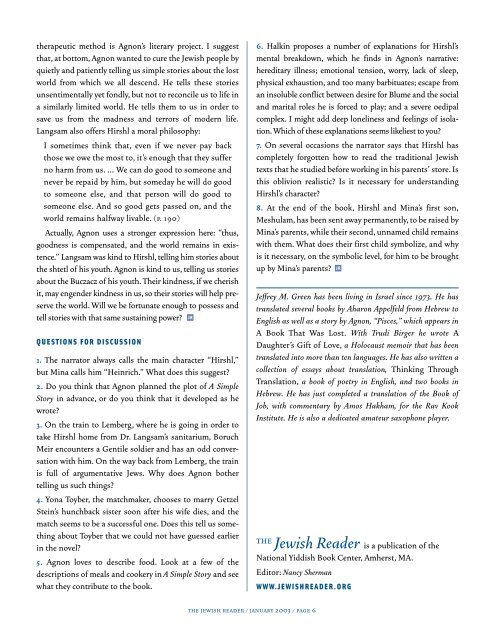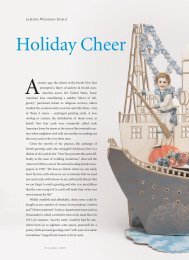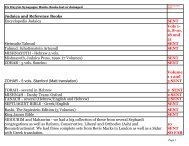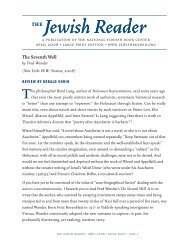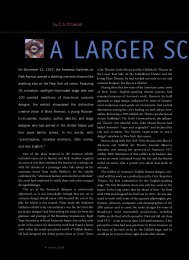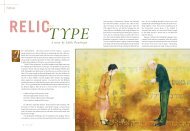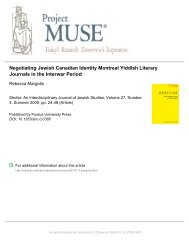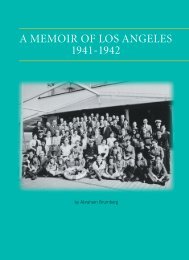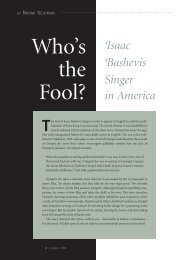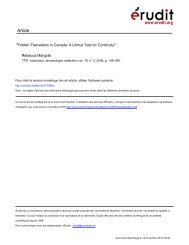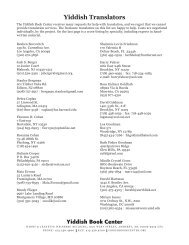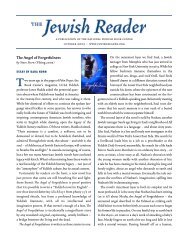Download The Jewish Reader - Yiddish Book Center
Download The Jewish Reader - Yiddish Book Center
Download The Jewish Reader - Yiddish Book Center
You also want an ePaper? Increase the reach of your titles
YUMPU automatically turns print PDFs into web optimized ePapers that Google loves.
therapeutic method is Agnon’s literary project. I suggestthat, at bottom, Agnon wanted to cure the <strong>Jewish</strong> people byquietly and patiently telling us simple stories about the lostworld from which we all descend. He tells these storiesunsentimentally yet fondly, but not to reconcile us to life ina similarly limited world. He tells them to us in order tosave us from the madness and terrors of modern life.Langsam also offers Hirshl a moral philosophy:I sometimes think that, even if we never pay backthose we owe the most to, it’s enough that they sufferno harm from us. … We can do good to someone andnever be repaid by him, but someday he will do goodto someone else, and that person will do good tosomeone else. And so good gets passed on, and theworld remains halfway livable. (p. 190)Actually, Agnon uses a stronger expression here: “thus,goodness is compensated, and the world remains in existence.”Langsam was kind to Hirshl, telling him stories aboutthe shtetl of his youth. Agnon is kind to us, telling us storiesabout the Buczacz of his youth. <strong>The</strong>ir kindness, if we cherishit, may engender kindness in us, so their stories will help preservethe world. Will we be fortunate enough to possess andtell stories with that same sustaining power? JRQUESTIONS FOR DISCUSSION1. <strong>The</strong> narrator always calls the main character “Hirshl,”but Mina calls him “Heinrich.” What does this suggest?2. Do you think that Agnon planned the plot of A SimpleStory in advance, or do you think that it developed as hewrote?3. On the train to Lemberg, where he is going in order totake Hirshl home from Dr. Langsam’s sanitarium, BoruchMeir encounters a Gentile soldier and has an odd conversationwith him. On the way back from Lemberg, the trainis full of argumentative Jews. Why does Agnon bothertelling us such things?4. Yona Toyber, the matchmaker, chooses to marry GetzelStein’s hunchback sister soon after his wife dies, and thematch seems to be a successful one. Does this tell us somethingabout Toyber that we could not have guessed earlierin the novel?5. Agnon loves to describe food. Look at a few of thedescriptions of meals and cookery in A Simple Story and seewhat they contribute to the book.6. Halkin proposes a number of explanations for Hirshl’smental breakdown, which he finds in Agnon’s narrative:hereditary illness; emotional tension, worry, lack of sleep,physical exhaustion, and too many barbituates; escape froman insoluble conflict between desire for Blume and the socialand marital roles he is forced to play; and a severe oedipalcomplex. I might add deep loneliness and feelings of isolation.Which of these explanations seems likeliest to you?7. On several occasions the narrator says that Hirshl hascompletely forgotten how to read the traditional <strong>Jewish</strong>texts that he studied before working in his parents’ store. Isthis oblivion realistic? Is it necessary for understandingHirshl’s character?8. At the end of the book, Hirshl and Mina’s first son,Meshulam, has been sent away permanently, to be raised byMina’s parents, while their second, unnamed child remainswith them. What does their first child symbolize, and whyis it necessary, on the symbolic level, for him to be broughtup by Mina’s parents? JRJeffrey M. Green has been living in Israel since 1973. He hastranslated several books by Aharon Appelfeld from Hebrew toEnglish as well as a story by Agnon, “Pisces,” which appears inA <strong>Book</strong> That Was Lost. With Trudi Birger he wrote ADaughter’s Gift of Love, a Holocaust memoir that has beentranslated into more than ten languages. He has also written acollection of essays about translation, Thinking ThroughTranslation, a book of poetry in English, and two books inHebrew. He has just completed a translation of the <strong>Book</strong> ofJob, with commentary by Amos Hakham, for the Rav KookInstitute. He is also a dedicated amateur saxophone player.the<strong>Jewish</strong> <strong>Reader</strong> is a publication of theNational <strong>Yiddish</strong> <strong>Book</strong> <strong>Center</strong>, Amherst, MA.Editor: Nancy ShermanWWW.JEWISHREADER.ORGthe jewish reader / january 2003 / page 6


